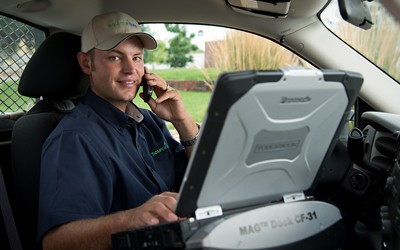
2013 Mobile Star Awards Winner:
> Enterprise Mobile Application Development — Mobility Studio
> Enterprise Field Service — ClickMobile
> Enterprise Workforce Management — Service Optimization Suite
> Success Story: Field Service Case Study — SourceGas
> Enterprise Software & Services Visionary — ClickSoftware CEO Moshe BenBassat
2012 Mobile Star Awards Winner:
> Enterprise Field Service — Service Optimization Suite
> Enterprise Workforce Management — Service Optimization Suite
> Success Story: Field Service Case Study — Vivint with ClickSoftware
> Visionary: Enterprise Software & Services — ClickSoftware CEO Moshe BenBassat
Mobile Field Service Case Study: SourceGas
 Work orders processed per miles traveled is a key performance indicator (KPI) for utility companies, and is especially significant for SourceGas, a natural gas distribution utility that serves Colorado, Nebraska, Wyoming and Arkansas. Maximizing driver efficiency takes on even more importance in the utility’s rural territories where re-routing technicians means hefty fuel, maintenance and other costs.
Work orders processed per miles traveled is a key performance indicator (KPI) for utility companies, and is especially significant for SourceGas, a natural gas distribution utility that serves Colorado, Nebraska, Wyoming and Arkansas. Maximizing driver efficiency takes on even more importance in the utility’s rural territories where re-routing technicians means hefty fuel, maintenance and other costs.
 With manual processes
With manual processes
driving its dispatch systems, SourceGas wasn’t optimizing work orders. So, the company decided to upgrade their aging mobile dispatch system, which processes approximately 500,000 work orders per year to roughly 500 field technicians on mobile devices. When they began searching for a new mobile solution to keep up with regulatory and business changes, automating work order and workforce scheduling processes were key priorities. SourceGas’ predecessor had installed their original mobile system in 2000, when mobile applications were still in relative infancy. The utility hadn’t made any major updates to the system along the way so the solution was outdated.
When exploring mobile upgrade options, SourceGas wanted most of the implementation handled in-house, using vendor support for development or configuration only when roadblocks arose. The organization’s intent was threefold. First, reduce implementation costs. Second, eliminate the cumbersome maintenance processes of its legacy system, which was custom-coded by vendors. Third, ensure the new system met unique requirements – such as time reporting – and strict government regulations.
With these goals in mind, SourceGas chose to implement SAP Workforce Scheduling and Optimization by ClickSoftware to integrate with its existing SAP landscape – including SAP ERP and SAP Customer Relationship Management (SAP CRM). Automating work scheduling was an obvious place to start because SourceGas believed automation had significant advantages over manual scheduling. Manually dispatching all work was time-consuming for dispatchers, and without systematized scheduling policies it was difficult to consistently assign workloads in alignment with business objectives.
While the system was custom-built to meet SourceGas’ needs, it is still relatively early to determine all tangible benefits. SourceGas has completed nearly 400,000 work orders and paid nearly 1,000,000 timesheet records since go-live; yet, more data needs to be collected before analysis sheds enough light on efficiencies and benefits.
Moving forward, SourceGas plans to use SAP Workforce Scheduling and Optimization to improve the customer experience -possibly allowing customers to place orders online, sending text messages to alert customers when technicians are en route, and collecting digital signatures and processing payments from customers directly in the field.
Learn more about ClickSoftware solutions.
Meet ClickSoftware’s Moshe BenBassat.
See how ClickSoftware helped Vivint cut field service costs by 40%.




